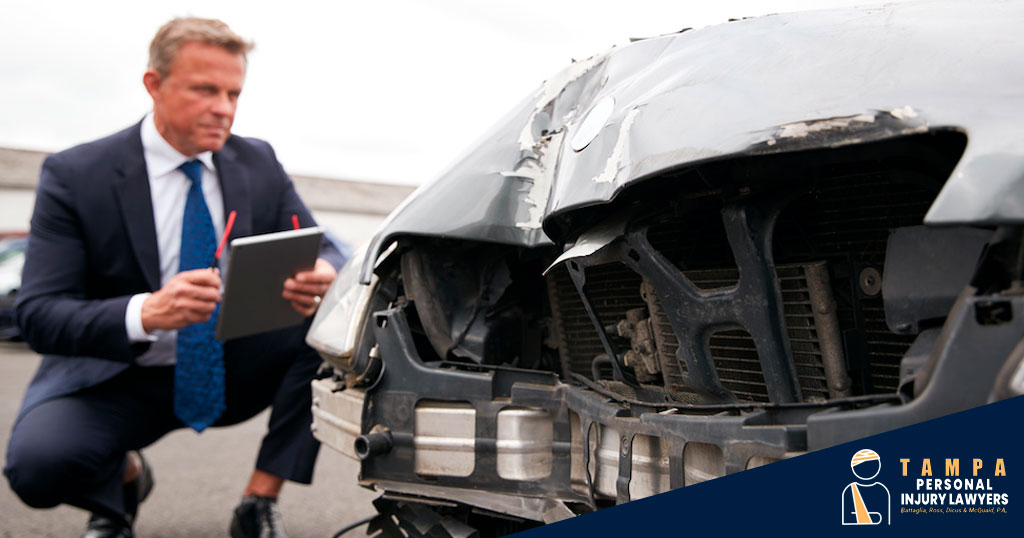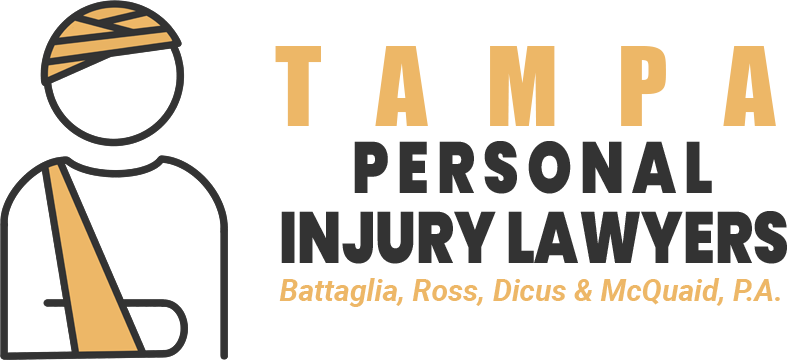Not all car accident cases are clear-cut or straightforward; sometimes, establishing liability can prove to be an uphill battle. In this article, we’ll discuss what it means when an insurance company only accepts partial liability (or fault) and some scenarios when they might do so.
This basically means the insurance company is claiming that you or another party are partially at fault for the accident. Or, they may claim that multiple parties are at fault for the accident.
Being involved in a car accident is already a difficult and confusing process. But when the other driver and their insurance company only accept a percentage of fault or outright deny your claim, things can get complicated. There are steps you can take to protect your rights if you believe the at-fault insurance company did not fairly assess and distribute fault after an accident. Our Tampa car accident lawyers can help you get fair compensation for the damages you suffered.
Table of Contents
ToggleIn What Situations Would the Insurance Company Only Accept a Percentage of Fault?
Let’s say you get hit from behind while in traffic or someone hits your parked car. It seems obvious that whoever hit you is the at-fault party, right? Wrong. While it seems obvious to assume they are at fault, you have to consider the accident in context. That’s what the insurance company will do, and they’ll find any way they can to minimize their own liability.
Once an insurance company conducts its investigation, it may come up with a reason why you are partially at fault for the accident. For instance, let’s say a car was driving recklessly in a parking lot, but your car was parked illegally. In this case, the insurance company would say that since you violated a traffic law, you are partially at fault for contributing to the accident.
What Happens When the Insurance Company Is Only Willing to Accept Partial Fault?
So, if the at-fault party’s insurance company only accepts a portion of liability, that will affect the amount of compensation you can potentially seek. This rule in Florida is called “comparative fault.” If the insurance company were to accept 100% liability for the accident, you’re entitled to claim 100% of the accident-related damages you suffered.
However, if they only accept a percentage of the fault (let’s say they accept 60% of the fault and assert that you contributed 40% of the fault), you could only seek compensation for 60% of accident-related damages.
Car accident damages include, but are not limited to:
- Medical bills
- Lost income
- Diminished earning capacity because of your accident injuries
- Pain and suffering
- Emotional and mental distress
- Future medical bills
- Loss of companionship
- Loss of consortium
- Loss of enjoyment in life
Now, if the other party’s insurance company alleges that you are partially at fault for the accident, you can only claim up to the percentage of fault they accept. That is, if they accept 70% fault, that’s the maximum damage recovery you can claim. If they accept 65% fault, you can claim up to 65% of damages, and so on and so forth. Basically, the less fault they accept, the less compensation you are entitled to.
Tampa’s Previous “Pure Comparative Negligence” Laws
Before Governor Ron de Santis signed HB 837 earlier this year, Florida operated under a pure comparative negligence system. Under a pure comparative negligence system, a person can still recover damages, no matter how much they are at fault. So, even if you are found to be 90% responsible for causing the accident, under pure comparative negligence, you can still seek 10% damage compensation.
The bottom line with comparative negligence is that your compensation amount is affected by your degree of fault. But pure comparative negligence doesn’t put a limit on how much fault you contributed; you can seek damages no matter what. Such a system (pure comparative negligence) is much more favorable for the plaintiff or claimant, while modified comparative negligence is seen as more forgiving to the defendant.
Tampa’s New Comparative Fault Laws (As of 2023)
Every state has its own method of determining comparative or contributory negligence, as we will discuss later in the article. Let’s say you get into an accident involving more than just two motor vehicles. In that case, comparative negligence laws become relevant to determine how much each party is at fault and how much they are responsible to pay.
Before March 24, 2023, Tampa used pure comparative negligence laws. However, since the recent torn reform in House Bill 837, Tampa has switched to a modified comparative negligence system. Under the new modified comparative negligence system in Tampa, individuals are prohibited from seeking compensatory damages if they are found to be more than 50% responsible for contributing to the accident. If a person is found to be more than 50% responsible for contributing to a car accident, they no longer have the right to seek compensation.
However, if an individual is found to be less than 50% at fault for causing the accident, they may still recover compensation for their damages and losses. The catch is that their award amount will be reduced by their percentage fault. This is usually determined by a judge or jury in Tampa.
To illustrate, consider an example where a driver sustains $2 million in damages after a severe collision with a commercial truck. If the truck driver was primarily at fault, but the injury victim of the passenger vehicle was assigned 30% fault, they could only win up to 1.4 million. Bear in mind that this is just an example, and your accident case will have its own unique circumstances. You’ll need an experienced Tampa car accident lawyer to assess your damages and can accurately help you determine the value of your damages after modified comparative negligence is applied.
Other Models of Comparative Negligence
In addition to pure comparative and modified comparative negligence standards, there’s another type of system that only a few states use. Alabama, Virginia, North Carolina, Maryland, and Washington D.C. use a system known as “Pure contributory negligence.” This is a much stricter model that differs vastly from the comparative negligence models.
Under pure contributory negligence, plaintiffs cannot collect any damages if they are even 1% responsible for causing the accident. So, contributing to the accident at all, you cannot seek damage compensation.
If the Other Insurance Company Claims You’re Partially at Fault, They Need Evidence to Prove It
Once the other insurance company claims that you are partially at fault for the accident, you might be partially liable for your own injuries. But first, they’ll need to meet a standard of proof to legitimately show that you were partially at fault. They might need to provide evidence that you made a preventable mistake (or were otherwise negligent) and that your negligence directly contributed to causing your injuries.
If the insurance company does claim that you are partially at fault, you need to speak with a knowledgeable Tampa personal injury lawyer who has experience dealing with and winning cases that involve modified comparative negligence.
A skilled lawyer will know how to devise a plan to strategically rebuttal their allegations to minimize your percentage of fault. You need strong legal representation to level the playing field because insurance companies have all sorts of tactics they use to minimize their liability. Your attorney can help look into how they calculated your percentage of fault and contest any unfair or untrue allegations.
Tampa Insurance Company Tactics With Comparative Negligence
Tampa insurance companies want to protect their bottom line, even if that comes at the cost of innocent injury victims. They often use comparative negligence as a tactic to reduce the value of claims and pay less. Even when liability is clear and obvious, insurance companies still deny or undervalue claims.
By offering reduced compensation (by whatever amount of fault they claim you are responsible for), they save money and protect their own profits. Insurance adjusters also sometimes use shoddy tactics because they know most people won’t file a lawsuit. For example, they will undervalue your claim and try to give you a quick cash offer while you’re still vulnerable and in shock after the accident. However, if you hire a Tampa car accident lawyer and file a personal injury claim, you will almost certainly get a higher financial award.
Traffic Citations Are Not Permissible Evidence in Florida Courts
Most car accident cases get settled out of court. But if your car does go to court, even the slightest comment like “I didn’t get the ticket; the other driver did” could result in a mistrial. This is why you need your attorney to prepare you for court.
The reason for this is that traffic citations and tickets are not admissible evidence in a personal injury case. This sounds counterintuitive, as you would think whoever got the ticket is the at-fault party. Even if the other party did receive a traffic citation or moving violation, an independent investigation can affect the outcome or the interpretation of that citation.
Traffic citations are not permissible evidence in court because Tampa police and law enforcement are not considered actual witnesses to motor vehicle collisions (Florida Statute 316.066(4). Under this statute, law enforcement statements should be without prejudice to either party and also may not be used as evidence in court.
Instead, the decision of the judge or jury is based solely on the cases presented by each party’s lawyer. That’s why you need an experienced Tampa personal injury lawyer who is ready to devise a winning plan and has experience with car accident litigation.
You Need to Gather Evidence After a Tampa Car Accident
AFTER THE accident, it’s vital to gather as much evidence as you can at the scene. Evidence such as pictures of injuries, property damage, and the accident scene can be very telling. This can help determine fault and support your claim if the insurance company tried to deny liability or over-assign fault.
Be Sure to Report the Accident and Seeking Medical Attention Right Away
Lastly, don’t forget to report the accident to your own insurance company. Even if the other driver denies liability, your insurance company needs to know about the accident and may be able to help you through the claims process. Be sure to get a copy of the police report if they come to the accident scene. If not, you can file an accident report online here.
However, if you were injured in the accident, you need to call for medical assistance immediately. Even if you feel okay, your injuries might be masked by the adrenaline and shock that initially occur following a motor vehicle collision.
Contact an Experienced Tampa Car Accident Lawyer Who Can Help Win Your Case
If you or a loved one was injured due to a negligent driver in Tampa, we strongly encourage you to reach out to our team of skilled Tampa auto accident lawyers. Handling a personal injury claim independently is extremely difficult and challenging, especially when going up against big insurance companies that are geared up with their own legal teams and tactics.
Not to worry, as our knowledgeable Tampa car accident lawyers fight tirelessly to get you the compensation you deserve and protect you from getting exploited by insurance companies. We can help you determine the accurate scope of your damages and the degree of fault you may have contributed.
From negotiating with the insurance company to filing a lawsuit or representing you in court, we will help you navigate your claims process from start to finish.
Call us today for your free initial consultation.






























